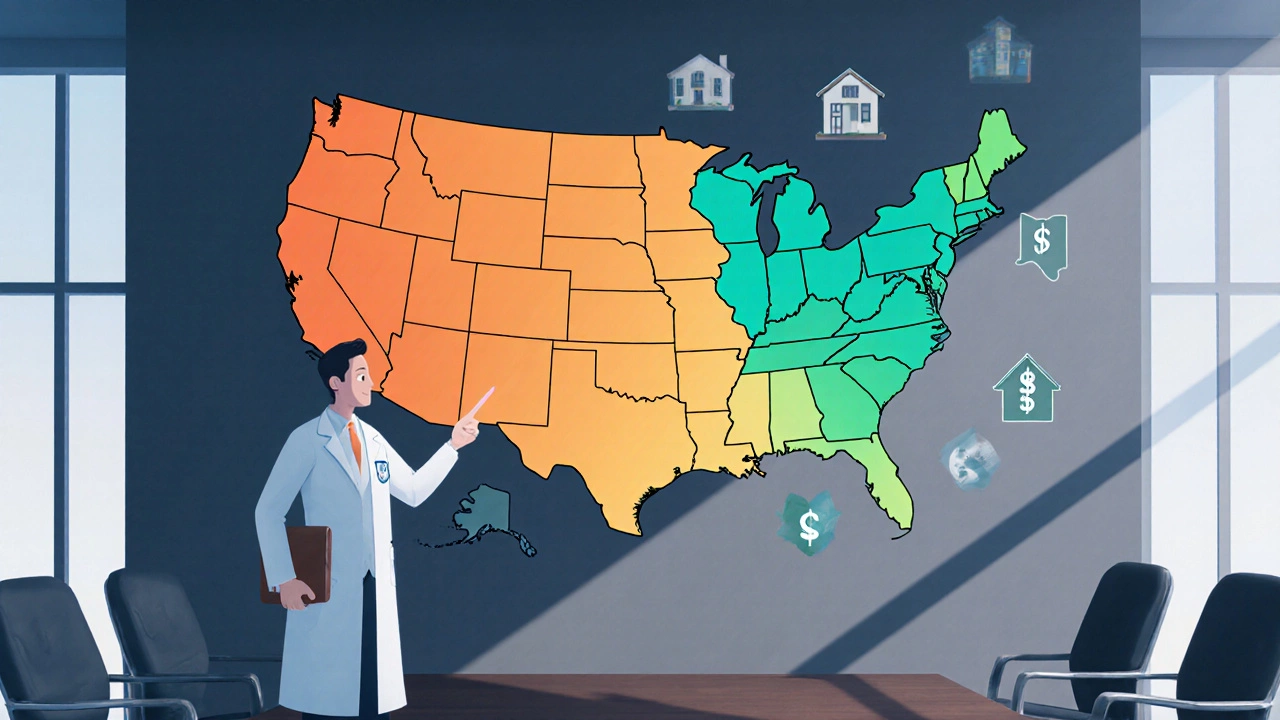MBBS Doctor Salary Estimator
Estimated Annual Compensation
Enter your details and click "Estimate My Salary"
Base Salary: -
Bonuses: -
Overhead Allowance: -
Total Compensation: -
Thinking about how much an MBBS doctor can pull in the United States? The answer isn’t a single figure-it depends on specialty, state, experience, and the route you take to practice here. This guide breaks down the real numbers for 2025, the licensing steps, and the levers you can pull to boost your paycheck.
Key Takeaways
- Average total compensation for a fully licensed physician in the US is about US$ 271,000 per year (2025 data).
- Specialties like orthopedics, cardiology, and radiology top the chart, often exceeding US$ 500,000.
- MBBS graduates must clear the USMLE, complete a residency, and obtain a state medical license before earning a full doctor’s salary.
- Geography matters: states with high cost of living (California, New York) pay more, but after adjusting for expenses, mid‑west offers competitive take‑home pay.
- Negotiating contracts, securing fellowship training, and choosing private practice vs. academic employment can shift earnings by 15‑30%.
Understanding the US Medical Salary Landscape
The United States has the highest physician earnings globally, but the data pool mixes MDs, DOs, and foreign‑trained doctors. For clarity, we’ll focus on the compensation route that an MBBS doctor who becomes a licensed physician after completing the US residency pathway can expect.
According to the American Medical Association’s 2025 compensation report, the median annual salary for all physicians is US$ 271,000. That figure includes base salary, bonuses, profit‑sharing, and other incentives. However, it masks wide variation across specialties, practice settings, and regions.
Pathway from MBBS to a Licensed US Physician
Before any paycheck shows up, an MBBS graduate must clear four major hurdles:
- Pass the United States Medical Licensing Examination (USMLE) in three steps.
- Secure a residency spot through the Electronic Residency Application Service (ERAS) and the Match.
- Complete an accredited residency program (typically 3‑7 years depending on specialty). The program must be approved by the Accreditation Council for Graduate Medical Education (ACGME).
- Obtain a state medical license, which may require an additional exam (USMLE Step 3) and background checks.
During residency, doctors earn a stipend that ranges from US$ 65,000 to US$ 78,000 annually-far below a fully licensed doctor’s compensation. Only after completing residency (and possibly a fellowship) does the salary jump to the figures shown in the tables below.

Salary by Specialty (2025)
| Specialty | Average Salary | Typical Years of Training |
|---|---|---|
| Orthopedic Surgery | US$ 527,000 | 5‑7 |
| Cardiology | US$ 511,000 | 5‑7 |
| Radiology | US$ 492,000 | 4‑5 |
| Gastroenterology | US$ 471,000 | 5‑6 |
| Dermatology | US$ 447,000 | 4‑5 |
| Emergency Medicine | US$ 374,000 | 3‑4 |
| General Surgery | US$ 363,000 | 5‑7 |
| Family Medicine | US$ 236,000 | 3‑4 |
| Pediatrics | US$ 228,000 | 3‑4 |
| Psychiatry | US$ 260,000 | 4‑5 |
These numbers factor in base salary, bonuses, and typical overhead allowances. If you’re an MBBS graduate aiming for a high‑pay specialty, plan for additional fellowship training, which can add 1‑2 years but often lifts earnings by 10‑20%.
Geography and Cost‑of‑Living Adjustments
State‑to‑state differences are stark. For example, the average physician salary in California is about 12% higher than the national median, but the cost of living index there is roughly 50% above the US average. Conversely, states like Ohio and Indiana offer salaries close to the national median while housing costs are 30% lower, resulting in a higher disposable income.
Below is a snapshot of median physician salaries in select states, adjusted for cost of living (COI) using the 2025 Numbeo index:
| State | Median Salary | COI Index | Effective Take‑Home* |
|---|---|---|---|
| California | US$ 315,000 | 144 | US$ 219,000 |
| New York | US$ 305,000 | 133 | US$ 229,000 |
| Texas | US$ 280,000 | 102 | US$ 274,000 |
| Illinois | US$ 268,000 | 107 | US$ 250,000 |
| Ohio | US$ 258,000 | 89 | US$ 290,000 |
*Effective Take‑Home = Salary ÷ (COI Index / 100). This simple metric helps compare real purchasing power across locations.
Factors That Influence Earnings
Beyond specialty and geography, several personal and professional levers affect your paycheck:
- Experience level: Physicians in their first year post‑residency earn ~15% less than seasoned peers.
- Practice setting: Private practice often yields higher gross income but comes with overhead; academic hospitals may pay less but offer research bonuses.
- Hours worked: Overtime, shift differentials in emergency medicine, and call duties can boost annual earnings.
- Negotiation: Signing bonuses, loan repayment assistance, and malpractice insurance coverage are negotiable items.
- Visa status: H‑1B or J‑1 physicians sometimes receive employer‑funded sponsorship fees, which can be factored into total compensation.

Improving Your Salary Prospects
Here’s a practical checklist for MBBS doctors who want to maximize earnings once they’re licensed:
- Target high‑pay specialties early; secure research or elective rotations in those fields during medical school.
- Earn strong USMLE scores (ideally >250 combined) to increase match chances at prestigious programs.
- Consider a fellowship in sub‑subspecialties (e.g., interventional cardiology) that command premium rates.
- When negotiating contracts, ask for:
- Signing bonus (10‑20% of first‑year salary)
- Relocation assistance
- Loan repayment programs, especially for physicians in underserved areas.
- Build a professional network through societies like the American Medical Association (AMA) to learn about high‑earning opportunities.
- Stay updated on Medicare reimbursement changes, as they directly impact practice revenue.
Common Pitfalls to Avoid
Many foreign‑trained doctors underestimate the financial timeline. While residency stipend feels modest, the cumulative debt can exceed US$ 300,000. Ignoring loan repayment options or failing to negotiate a fair contract can leave you earning far less than market rates. Also, be wary of “moonlighting” restrictions in some residency programs-violating them can jeopardize your license.
Next Steps Checklist
- Register for USMLE Step 1, 2CK, and 2CS (or their current equivalents).
- Compile ECFMG certification documents; submit them early.
- Research residency programs that sponsor visas; note their application deadlines.
- Calculate expected income vs. living costs for your top three preferred states.
- Draft a negotiation script for contract talks-include salary, bonuses, benefits, and malpractice coverage.
Frequently Asked Questions
What is the starting salary for an MBBS graduate after completing residency?
After finishing a 3‑year residency in a primary care field, the typical starting salary ranges from US$ 220,000 to US$ 250,000, depending on location and practice type.
Do I need to re‑take medical school exams in the US?
No. The USMLE is the only standardized exam required for licensing. Your MBBS degree is validated through ECFMG certification, which confirms you meet US standards.
Can I work while on a J‑1 visa during residency?
J‑1 residents can usually only work within their training program. Any additional paid work (moonlighting) requires explicit permission from the program director and the State Department.
How much does location affect my net income?
A doctor earning US$ 300,000 in New York may take home the equivalent of US$ 230,000 after accounting for housing, taxes, and daily expenses, whereas the same salary in Ohio could feel like US$ 280,000 in purchasing power.
Is it worth pursuing a fellowship for higher pay?
In many high‑demand specialties, a one‑year fellowship can lift annual earnings by 10‑20% and open doors to leadership roles that further increase compensation.
